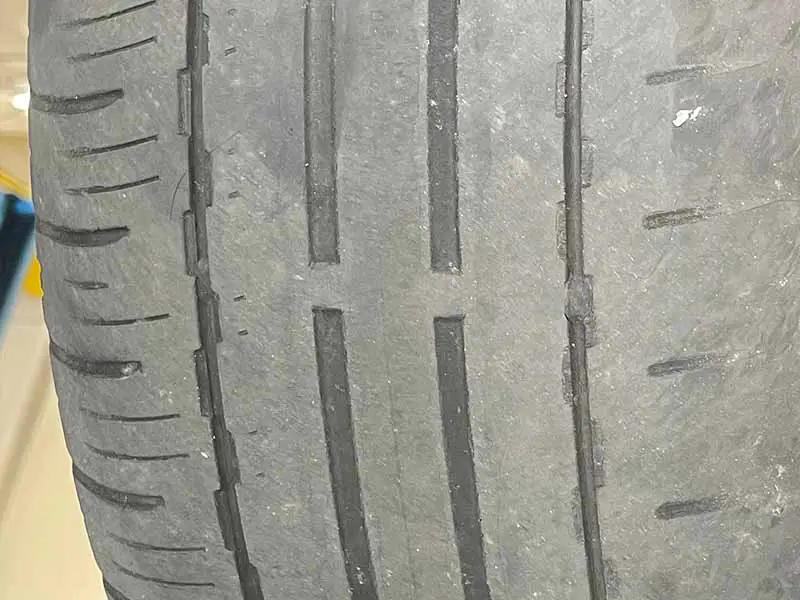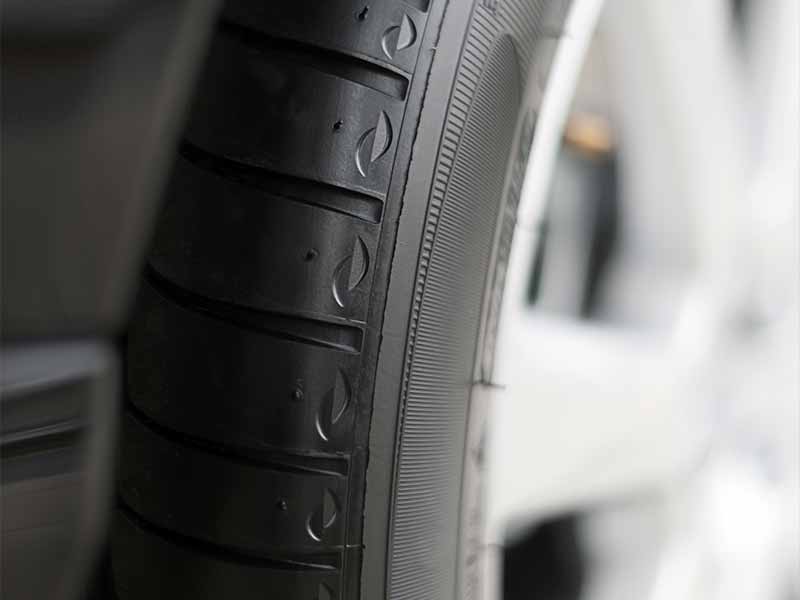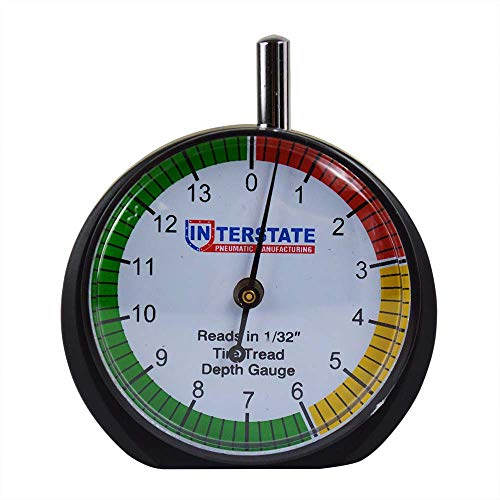Are your tires safe enough for the road? Discover how tire tread depth affects your vehicle’s performance and safety, and learn when it’s time to replace those worn-out tires before it’s too late!
Tire Tread Measurements
Tread wear is measured in 32nds of an inch from 11 or 10/32″ for new tires, 4/32″ for when it’s recommended to replace your tires, and 2/32″ for when your tires are legally considered bald in most states.
In this article, we’ll explore the importance of tire tread depth measurements, discuss various methods for measuring wear, delve into the effects of low tread depth, and provide essential tips for maintaining your tires to keep you safe on the road.
Let’s take a closer look.
Understanding Tire Tread Depth Measurements
Tire wear is a important aspect of your vehicle’s safety and performance. In this section, we’ll dive into the different measurements of tread wear and what they mean for you as a driver. The goal here is to help you understand how tread depth affects your tires, and when it’s time to consider a tire replacement.
What is Tread Depth?
Tread depth refers to the height of the tire tread, which is the pattern of grooves and ridges on a tire’s surface. These grooves and ridges help your tires grip the road, provide traction, and channel water to prevent hydroplaning. Tread wear is measured in 32nds of an inch, and as your tires wear down, the depth of the tread decreases.
Range of Tread Depth Measurements
Now that we know what tread depth is, let’s look at the range of tread depth measurements and their significance:
- New Tire Tread Depth (11/32″ or 10/32″)
- When you buy new tires, their tread depth usually ranges between 11/32″ and 10/32″. This depth provides optimal traction and safety for your vehicle. While you can’t control the natural wear and tear of your tires, it’s still important to be aware of your tread depth and how it may affect your driving experience.
- Good Tread Depth (9/32″ to 5/32″)
- As your tires wear down, they will still provide adequate traction and grip when their tread depth is within this range. You can continue to drive safely with this amount of tread wear, but keep in mind that grip on wet roads will gradually decrease, particularly when panic-braking.
- Time to Replace Tire (4/32″)
- When your tire tread depth reaches 4/32″, it’s time to start thinking about replacing your tires. At this depth, your tires’ ability to provide sufficient traction in wet conditions becomes significantly reduced, especially during panic-braking situations. Stopping distances will be greatly increased, lateral grip will be reduced, and the risk of hydroplaning is significantly higher. It’s essential to replace your tires soon to ensure your safety on the road.
- Legal Requirement for Tire Replacement (2/32″)
- In most states, the minimum legal tread depth is 2/32″. At this point, your tires are considered “bald,” and driving on them is unsafe. Bald tires have a higher risk of hydroplaning and significantly longer stopping distances on wet roads. It can take as much as twice the distance to come to a complete stop on a wet road when panic braking with tires that have only 2/32″ of remaining tread compared to their wet performance when new. Although some states may have different regulations or no specific restrictions, it’s highly recommended to replace your tires if they reach this level of wear for the sake of safety.
By understanding the different tread depth measurements, you can better monitor the condition of your tires and ensure your vehicle remains safe and reliable. Regularly checking your tire tread wear will help you stay on top of when it’s time to replace your tires, which ultimately contributes to a safer driving experience.
How to Measure Tread Depth
Measuring your tire tread depth is an essential part of maintaining your vehicle’s safety and performance. In this section, we’ll explore two methods you can use to measure your tire tread depth: using a penny and using a tread depth gauge.
Penny Tire Test
One of the easiest and most affordable ways to measure tread depth is by using a penny. Here’s how to do it:
- Find a clean and undamaged penny.
- Insert the penny into one of the tire’s grooves with Abraham Lincoln’s head facing down.
- Look at where the top of Lincoln’s head meets the tread.
- If the tread covers any part of Lincoln’s head, you have at least 2/32″ of tread depth remaining.
- If you can see the entire head, your tread depth is below 2/32″, and it’s time to replace your tire.
Keep in mind that the penny test is a quick and easy method, but it’s not the most accurate. For more precise measurements, consider using a tread depth gauge.
Using a Tread Depth Gauge
A tread depth gauge is a small, inexpensive tool that provides a more accurate measurement of your tire tread depth. Follow these steps to use a tread depth gauge:
- Purchase a tread depth gauge from an auto parts store or online retailer.
- Locate one of the tire’s grooves and insert the probe of the gauge into it.
- Push the gauge down until the base is flush against the tire’s surface.
- Read the measurement on the gauge’s scale, which will show the tread depth in 32nds of an inch.
Be sure to check multiple grooves around the tire to get an average reading, as tire wear can be uneven.
Easy-To-Read Tread Depth Gauge
Checking Tire Wear Bars
Tire wear bars are small, raised sections of rubber between the tread blocks at the bottom of the main tread groove that becomes more visible as your tire wears down. They serve as a built-in indicator of when it’s time to replace your tires. When the tread is worn down to the same level as the wear bars, your tires have reached the minimum legal tread depth of 2/32″, and it’s time for a replacement.
To check tire tread wear indicator bars, follow these steps:
- Locate the wear bars on your tire, which are usually found between the grooves of the tread pattern.
- Inspect the wear bars and compare their height to the surrounding tread.
- If the tread is even with the wear bars, it’s time to replace your tires.
- If the tread is still noticeably higher than the wear bars, your tires are still safe to use.

Effects of Low Tread Depth
Driving on tires with low tread depth can have significant consequences on your vehicle’s performance and safety. In this section, we’ll discuss the effects of low tread depth on your driving experience, including the increased risk of hydroplaning and longer stopping distances.
Decreased Traction and Grip
As your tire tread depth decreases, so does your tire’s ability to provide sufficient traction and grip, particularly on wet surfaces. This reduced traction can result in less control of your vehicle, making it harder to maintain stability during cornering and braking.
Increased Risk of Hydroplaning
When driving on wet roads, your tire’s grooves channel water away from the tire’s contact patch, allowing the tire to maintain grip. However, as tread depth decreases, the tire’s ability to channel water diminishes, increasing the risk of hydroplaning. Hydroplaning occurs when a layer of water builds up between the tire’s surface and the road, causing the tire to lose contact with the road and resulting in a loss of control.
Longer Stopping Distances
Low tread depth can significantly impact your vehicle’s stopping distance, especially on wet roads. Tires with only 2/32″ of remaining tread can take as much as twice the distance to come to a complete stop on a wet road when panic braking, compared to their wet performance when new. This increased stopping distance can potentially result in accidents and decreased safety.
Lower Fuel Efficiency
Finally, low tire tread depth can negatively affect your vehicle’s fuel efficiency. Worn tires can create increased rolling resistance, requiring your vehicle to work harder and consume more fuel to maintain the same speed.
Resources
Below are some links you may find helpful when learning about tires
Final Thoughts
It’s important to regularly monitor your tire tread depth, understanding when it’s time for a replacement and taking action before it’s too late. Remember the key takeaway: proper tire maintenance, including monitoring tread depth, can help you avoid accidents, save money on fuel and tire replacements, and provide a better overall driving experience.
To conclude, consider this thought-provoking insight from the world of motorsports: “Tires are the most important part of a race car because they’re the only part that touches the ground.” While your daily commute may not be a high-speed race, the same principle applies to passenger cars and trucks. Always prioritize your tire’s condition and tread depth, and you’ll be well on your way to safer and more enjoyable journeys on the road.
Good luck and happy motoring.







